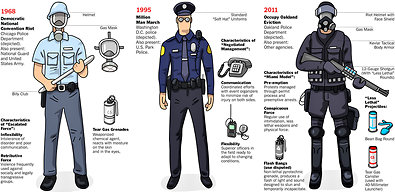Just as the styles of protest have changed from one generation to the next, so have the styles of protest policing. Technological advances, training innovations and changing attitudes toward the right to assemble have all shaped the way the police handle the challenges of large demonstrations. During the 1960s and ’70s, police officers treated many protests as a threat to the social order and responded with brute force. In the 1980s and ’90s, demonstrations tended to be less confrontational and the police responded with more accommodating tactics.
Following the “Battle in Seattle” protests against the World Trade Organization in 1999, a more restrictive, preemptive and aggressive form of protest policing emerged at the 2003 protests in Miami over the Free Trade Area of the Americas. The current Occupy demonstrations have adopted a defiant and disruptive style of protest that has pushed the boundaries of the First Amendment, but the response has been mixed. While many cities have evicted encampments and blocked marches through enormous shows of force, others have tried to use communication and flexibility to preserve the nonviolent if disruptive character of these protests.
Chi Birmingham is an illustrator. Alex S. Vitale, an associate professor of sociology at Brooklyn College, is the author of “City of Disorder: How the Quality of Life Campaign Transformed New York Politics.”
Copyright 2011 The New York Times Company. Reprinted from the New York Times, SundayReview, of Sunday, December 4, 2011.

